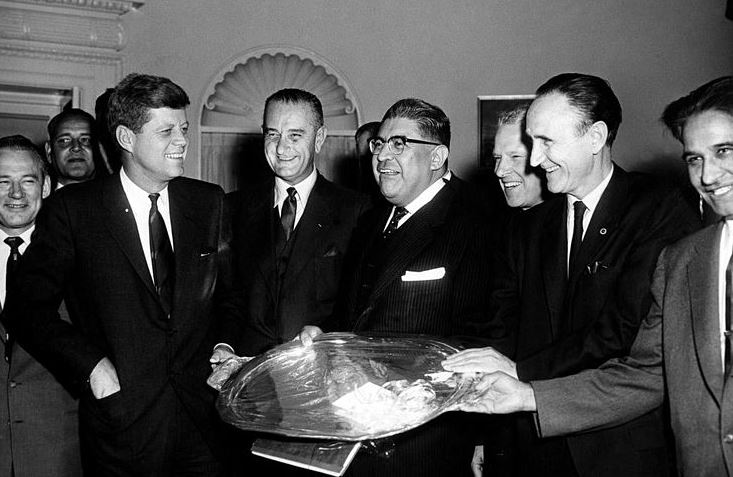By Raymond Douglas Chong, AsAmNews Staff Writer
Dalip Singh Saund, “Judge Saund,” blazed the trail as the first Asian American Congressmember when the citizens of Riverside and Imperial counties in Southern California elected him in 1956.
As a British Indian immigrant, he faced racial discrimination despite being a naturalized American citizen and achieving business success in farming.
Senator Hiram Leong Fong, a Chinese American, and Representative Daniel Inouye, a Japanese American, followed his path to Congress, from the new state of Hawaii.
In Congressman from India, his 1960 autobiography, Saund wrote:
This book is the simple story of the struggles, sorrows and joys, defeats and recoveries, of a twenty-year-old native of India who came to the United States and, nearly two-score years later, became a United States congressman. My guideposts were two of the most beloved men in history, Abraham Lincoln and Mahatma Gandhi. My constant inspiration was the memory of my wise though unlettered mother, who had loved me dearly and taught me the lessons in good living.
Dalip Singh Saund: Legacy Leader
British India
Saund, born in the village of Chhajjalwaddi in the province of Punjab of British India, on September 20, 1899, followed the Sikh faith. His illiterate father worked as a construction contractor. He went to boarding school in the city of Amritsar.
Saund attended the University of Punjab in Lahore, where he majored in mathematics. He actively supported the movement for an independent India from British rule. Mahatma Gandhi advocated nonviolence and civil disobedience for Indian independence. During World War I, Saund read the speeches of President Woodrow Wilson in the news. He discovered the writings of President Abraham Lincoln. Lincoln’s 1863 Gettysburg Address deeply moved him. In 1919, he graduated with a bachelor’s degree.
Saund decided to pursue an American education in canning, a method of food preservation. He expected to return to enhance the canning industry.
American Education
From Bombay, India, to England and Southampton to Ellis Island, New York, Saund arrived aboard S.S. Philadelphia on September 27, 1920.
Among the passengers aboard the S.S. Philadelphia was an attractive and charming young blonde lady who was returning to New York to join her husband. She was interested in India, and we talked together quite often. She had an eleven-year-old daughter with her and we all became very good friends. New York was their destination while I was bound for San Francisco. Eight years later we were to meet in Los Angeles again under very strange and providential circumstances.
A federal immigration officer told Saund, “You are now a free man in a free country.” He arrived at Berkeley, California, his final destination. He enrolled in the University of California’s agricultural school and mathematics department. He lived at a clubhouse with fellow Indian students. He earned master’s and doctorate degrees in mathematics in 1924. He was involved with the Sikh temple at Stockton in the Central Valley.
Saund experienced racism of xenophobia beyond the campus. White Americans feared a “tide of turbans,’ by Indian immigration, similar to the yellow peril. On May 3, 1913, the California legislature enacted the Alien Land Law, which barred Asian immigrants from owning land. The federal Immigration Act of 1917 created an Asiatic Barred Zone that prohibited immigration from British India, Southeast Asia, the Pacific Islands, and the Middle East.
“Acceptance was very difficult to obtain in the atmosphere of California in those days, particularly for students from Asia,” Saund once said. “Prejudice against Asiatic people in California was very intense in the early twenties and I felt keen discrimination in many ways. Outside of the university atmosphere it was made quite evident that people from Asia–Japanese, Chinese, and Hindus–were not wanted.”
After his studies, his family informed Saund that British officials monitored his anti-British talks in America. He decided to stay in California. But because of his immigrant status, he could not secure a teaching job.
Desert Farming
Saund moved south to California’s Imperial Valley, where many Punjabi Sikhs farmed on irrigated fields in the Colorado Desert near the Salton Sea.
He initially worked as a foreman on a cotton picking gang. He entered the farming business to grow cotton, lettuce, alfalfa hay, milo maize, sugar beets, melons, onions, and celeries. He experienced crop failures and bounties depending on the weather, the pestilences, and the market. California law prevented Saund from owning and leasing land. But he held his farming equipment. Saund opened his own fertilizer business as a distributor for farms around 1953.
“I have mentioned the prejudice and discrimination that existed against all Asiatics, including the Indians, at that particular time in California. Imperial Valley was not immune, and there is no denying the fact that there were persons in Imperial County who were prejudiced and antagonistic toward me,” he said. “But the majority of my neighbors and the people with whom I came in contact were extremely kind and always helpful. I recollect some of the experiences that I had when I first started. My neighbors, knowing how inexperienced I was, would come over and give me advice and offer on occasions to do the work for me, largely out of friendship and high respect for my wife.”
Interracial Marriage
In California, interracial marriage was taboo for fear of miscegenation, the interbreeding of people considered to be of different racial types. Since statehood, the California statute banned interracial marriage. In 1905, the amended California statute read, “no license must be issued authorizing the marriage of a White person with a Negro, mulatto, or Mongolian.”
“One evening I spoke at the Unitarian Church in Hollywood, and at the end of the meeting a young man came up to me, introduced himself as Emil J. Kosa, said he was an artist, and invited me to visit his home sometime. He said his mother and father were students of world politics and greatly interested in India. It was a casual invitation and I did not take it particularly seriously. Then a few weeks later I happened to meet Emil in a downtown restaurant. We recognized each other and he renewed his invitation, and this time I accepted. I was introduced to his parents and during the course of the conversation, Mrs. Kosa told me that when she was returning from Europe a few years before with her daughter she had met a young Indian student who was going to study fruit canning in the United States. I had no knowledge of any other Indian student beside myself who had been even remotely interested in this field. We compared notes and soon found that we had been passengers on the same boat, the S.S. Philadelphia, in 1920. Mrs. Kosa had been my shipboard friend, but her then eleven-year-old daughter Marian was now a beautiful and talented student of U.C.L.A.
One evening I was invited to speak before the Masaryk Club of which Mr. and Mrs. Kosa were members. Emil’s sister, Marian, was at that time a leader of a small dance group of U.C.L.A. coeds known as the Kosa group. They used to perform folk dances before various civic, diplomatic, and college groups. As the girls danced that night at the Masaryk Club, my eyes never left Marian. Suddenly I knew I was madly in love. I found myself in a terrible dilemma. Providence had brought me to the home of this spritely, winning blonde and I knew I was desperately in love. But here I was, twenty-eight years old, without a home, without a secure job, and no clear future in sight–a foreigner in a country that I loved and in which I had made my home, but where the laws even forbade me to become a citizen. I had fallen in love with the daughter of a well-known artist, a very beautiful and talented college girl at U.C.L.A. Also I knew that I had many rivals and that I could not possibly match their physical or material attributes. But once again luck was on my side. All through life I had been faced with many turning points and I had always been lucky. In this particular case my salvation lay in the fact that my future father-in-law and mother-in-law liked me. I carried on my courtship with persistence and unsurpassed devotion. These were all I could offer at that time. I had plenty of nerve and plenty of love.

Our courtship was not very long. I think the most persuasive weapon I had was the fact that I knew many passages of English, Hindu, and Persian poetry. I used to recite them to Marian and she would laugh and find great delight in them. She was remarkable in memorizing and can recite many of those poems to this day. I recall one passage from an Indian poem that struck her fancy: “I tremble at the tyranny of the shining sun, I am like a dewdrop on a desert thorn.”
I proposed to Marian by writing this sentence, word by word, in the sand at Laguna Beach one Sunday afternoon: “If I prove myself worthy, will you become mine?”
On July 21, 1928, in San Diego, Saund successfully married Marian Kosa despite she being Caucasian. But Marian lost her American citizenship. In 1922, Congress enacted the Cable Act, which required White American women who married aliens racially excluded from the naturalization process, to lose their American citizenship. In 1931, Congress amended the Cable Act that allowed White women to retain their American citizenship even if they married a person ineligible for naturalization.
Born in Cape Cod, Massachusetts, on August 3, 1906, Marian’s ancestors hailed from Czechoslovakia. She petitioned for American citizenship. The US District Court in Los Angeles certified her American citizenship on October 23, 1933.
Saund and Marian settled on a ranch in the community of Westmoreland in Imperial County. They raised three children. Dalip Jr., son, Julie and Ellie, daughters. Because of their mixed race, the children attended segregated Mexican and Negro public schools. Eventually, Marian returned to Los Angeles to live in Hollywood Hills with the children due to her hay fever allergy and community prejudice.
Marian graduated from the University of California at Los Angeles (UCLA) with a bachelor’s degree in education. She was an elementary school teacher in the Los Feliz neighborhood with Los Angeles public schools. Dalip Jr. served in the Korean War as an Army lieutenant. He received a bachelor’s degree in mechanical engineering from the California Institute of Technology and a doctorate in anthropology from UCLA. Julie and Ellie graduated from UCLA in education and taught.
American Politics
Since his American arrival in 1920, Saund was always involved in politics. As an Indian nationalist, he advocated for Indian independence from the British empire. He followed Mahatma Gandhi, who deployed nonviolent resistance to lead the successful campaign for India’s independence.
Across California, Saund passionately spoke at service clubs and civic groups. He authored My Mother India, a 1930 book about his experiences in Punjab and a critique of British imperialism. On 15 August 1947, India became a sovereign and democratic nation.
Saund followed American politics, especially the presidential elections. The benefits of the federal New Deal program under President Franklin Roosevelt deeply impressed Saund. Although he still was an immigrant, Saund said. Despite its racist flaws, Saund adhered to the values and principles of American democracy while pursuing his American Dream.
By 1932, I had positively and definitely become a Democrat by outlook and conviction.
Saund recognized that an unjust federal law prevented him from becoming an American citizen. As President of the Indian Association of America, he organized efforts to open citizenship to people of Indian natives living in America. Congress enacted the Luce–Celler Act of 1946 that allowed 100 Indians from Asia to immigrate to the United States per year, allowing Indian natives to naturalize as American citizens Saund became an American citizen on December 16, 1949.
I had become a close part of the American life. I had married an American girl, and was the father of three American children. I was making America my home. Thus it was only natural that I felt very uncomfortable not being able to become a citizen of the United States. My social life may have been full and rewarding, but the political desire in me was sorely frustrated. And I wanted to be a part of all American life, both social and political. I was every bit as aware of the political happenings on the American scene as anyone around me, and was acquainted with the history of America and the lives of its great men. I was dedicated to what is called the American way of life and yet when I looked in front of me I saw that the bars of citizenship were shut tight against me. I knew if these bars were lifted I would see much wider gates of opportunity open to me, opportunity as existed for everybody else in the United States of America. Instead of crying or complaining about the situation I decided to do something about it. The lives of the great Americans in the past and the examples of my neighbors who had started life in the desert against serious handicaps and made good were a strong source of inspiration.

Saund campaigned for public offices in Imperial County. Despite ugly challenges by White Americans about his walnut skin, South Asian ethnicity, and Sikh religion, he doggedly persevered in a positive tone, never attacking his opponents. In 1952, citizens elected him as Justice of the Peace – “Judge.” During his four years, he ended the red light district of Westmoreland. He was widely known for his legal acumen.
In 1956, citizens of Riverside and Imperial counties elected “Judge Saund” as their Democratic Congressmember. The Washington Post’s editorial said, “Californians have not always been hospitable to aliens and especially to aliens of Asian origin. In this election, they ignored ancestry and considered the individual.” He became the pioneer Asian American Congressmember. The world recognized his national star in American Congress.
In the halls of Congress, Saund focused on the needs of his District, especially farmers, ranchers, and businesses. He also supported the March Air Force Base during the Cold War. He served on two House committees, Foreign Affairs, and Interior & Insular Affairs. He promoted better American relationships with Asian, Middle Eastern, and African countries to stop communism.
Saund was a fierce supporter of the Civil Rights bill during his first term. The Judge used his story from an Indian immigrant to an American citizen while advocating its passage. The Civil Rights Act of 1957 established the United States Commission on Civil Rights and the United States Department of Justice Civil Rights Division.
On July 12, 1959, Congressman Dalip Singh Saund was interviewed on First Federal Presents (WCKT Miami).
Saund suffered a stroke on an airliner flying from Los Angeles to Washington, DC, on May 1, 1962. He lost the ability to speak or to walk. He lost his Congressional campaign for a fourth term.
Marian cared for Saund for his last decade of life. He suffered another stroke in 1972. He died at their Hollywood home on April 22, 1973. He rests at the Mausoleum of Christian Heritage of Forest Lawn Memorial Park in Covina, California.
On the House floor in the Capitol, Majority Leader Tip O’Neill of Massachusetts eulogized:
To chronicle all his legislative achievements and personal successes during his lifetime could not begin to pay Dalip Saund the justice and honor he deserves. Those of us who knew and admired him in the House, remember him as a man of boundless energy, personal integrity and strong convictions–consistently and tirelessly fighting for the right of “life, liberty, and the pursuit of happiness” for all Americans.
Close
Dalip Singh Saund led a phenomenal life, from a British Indian village to American Congress.
I have consistently, and with all the force at my command, supported civil-rights legislation in Congress. There is no room in the United States of America for second-class citizenship. In Uncle Sam’s family there are no foster children. All American citizens must enjoy equal rights under law. Discrimination of man against man in any form is repugnant to the ideals which all Americans cherish.
All these matters touch, in a greater or lesser degree, on the crucial issues facing America today. If we face them squarely and grapple with them fearlessly, the future of the great political experiment launched by the Founding Fathers will be assured.
Despite racial discrimination, the Honorable Dalip Singh Saund achieved his American dream as the pioneer Asian American Congressmember. Saund always believed in the promises of American democracy by our Founding Fathers.

AsAmNews is incorporated in the state of California as Asian American Media, Inc and has an application for non-profit 501c3 status with the IRS pending. Check out our Instagram account. Go to our Twitter feed and Facebook page for more content. Please consider interning, joining our staff, or submitting a story, or making a financial contribution. We are committed to the highest ethical standards in journalism. Please report any typos or errors to info at AsAmNews dot com.




